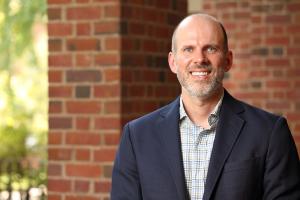
Norfolk's streets can quickly transform into waterways during heavy rains, disrupting transportation and emergency response efforts. Now, University of Virginia’s professor Jon Goodall and his team are leveraging artificial intelligence and machine learning to predict street-level flooding in real-time, helping the city respond faster to extreme weather events.
Goodall, a professor of civil and environmental engineering, has long used physics-based models, like TUFLOW, to simulate how rainfall and tides interact with Norfolk’s stormwater systems. While highly accurate, these models require hours to run, limiting their usefulness for immediate decision-making.
To address this challenge, Goodall’s team has trained machine learning models with historical flood data to develop an AI-powered system that can predict flooding in seconds. These models analyze a wide range of inputs, including rainfall, tide levels and street-specific data, offering rapid and reliable forecasts. This speed could be a game changer for urban planners and emergency responders, enabling faster warnings and more efficient resource allocation.
“The key advantage of machine learning is speed,” Goodall said. “With these models, we can provide predictions in real time, which is critical for cities like Norfolk where flooding can happen rapidly.”
Collaborators Contributing to Flood Modeling Efforts
This research is a collaborative effort involving experts from multiple institutions. Scientists at Thomas Jefferson National Accelerator Facility contribute advanced computing resources, while Old Dominion University researchers bring their deep knowledge of hydrology and environmental science in Norfolk. Together with UVA, these partners form the Joint Institute on Advanced Computing for Environmental Studies (ACES), launched to tackle regional environmental challenges. Each partner plays a key role in refining models, analyzing vast datasets, and developing practical solutions for predicting flood risks more efficiently.
AI for Smarter Flood Prediction
Goodall’s research incorporates advanced machine learning techniques like random forests and recurrent neural networks. Random forests combine many individual decision trees, each of which makes predictions based on different factors. By averaging the results, random forests improve accuracy and reliability, making them well-suited for complex problems like flood prediction, where multiple environmental factors are at play.
Recurrent neural networks (RNNs), on the other hand, recognize patterns over time by "remembering" previous inputs to predict future events. In flood modeling, RNNs analyze how past rainfall and tides influenced flood levels and use that information to forecast what will happen next. These models are particularly valuable for predicting events that unfold over time, like flooding, allowing urban planners to anticipate impacts as they develop.
Ongoing Improvements
Goodall and his team continue to refine the machine learning models to improve their accuracy, especially in predicting deeper water levels, which are more difficult to model due to limited data. His recent co-authored paper highlights how increased rainfall intensity driven by climate change can amplify flood risks in smaller watersheds, which are particularly vulnerable and underscores the need for updated infrastructure design that incorporates climate change forecasts and streamflow analysis.
Most current hydraulic, flood control and stormwater infrastructure — such as bridges, culverts, dams and sewer pipes — have been designed based on the assumption that climate conditions are stationary. This outdated assumption can lead to significant errors in designing for storms, either underestimating or overestimating flood risks. Underestimations could result in insufficient infrastructure, leading to flooding, property damage, and even loss of life. On the other hand, overestimations can result in overdesigned structures, wasting valuable resources and infrastructure funding.
Despite ongoing challenges, this research marks significant progress in using AI for real-time flood forecasting. Goodall’s findings contribute to a growing body of work aimed at helping communities better understand and adapt to the impacts of climate change on infrastructure, offering practical solutions to cities like Norfolk that are grappling with the effects of extreme weather.